Description
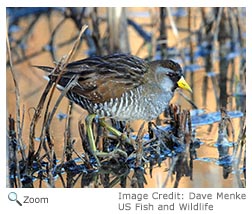 This small, shy marsh bird is 6-8 inches in length with a wingspan of 12 inches. It has a yellow bill and yellow legs. It has a brown body and wings, a gray chest and belly, and a black mask on its face. The sora is sometimes called the Carolina crake or the sora rail. This small, shy marsh bird is 6-8 inches in length with a wingspan of 12 inches. It has a yellow bill and yellow legs. It has a brown body and wings, a gray chest and belly, and a black mask on its face. The sora is sometimes called the Carolina crake or the sora rail.
Range 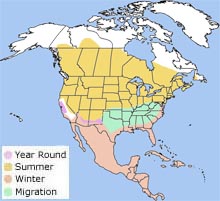 The sora breeds from British Columbia east to the Maritime Islands and south to California, Arizona, Oklahoma, and Pennsylvania. It usually winters along the Pacific and Atlantic coasts north to California and Virginia. The sora breeds from British Columbia east to the Maritime Islands and south to California, Arizona, Oklahoma, and Pennsylvania. It usually winters along the Pacific and Atlantic coasts north to California and Virginia.
Habitat
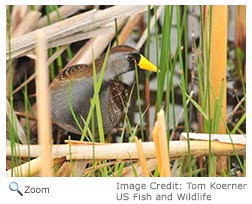 The sora lives in salt, brackish, and freshwater marshes; rice fields; and marshy ponds. It prefers areas with cattails, sedges, and other tall plants. The sora lives in salt, brackish, and freshwater marshes; rice fields; and marshy ponds. It prefers areas with cattails, sedges, and other tall plants.
|
|
Diet 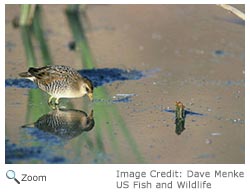 The sora eats seeds, insects and snails. It usually picks its food from the surface of the water, the ground, or off of plants, but it will sometimes probe in the mud or vegetation for food. The sora eats seeds, insects and snails. It usually picks its food from the surface of the water, the ground, or off of plants, but it will sometimes probe in the mud or vegetation for food.
Life Cycle 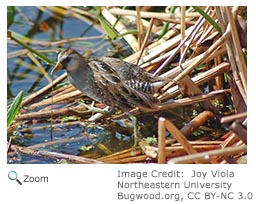 Soras form breeding pairs in the early spring. Both the male and the female preen for each other during courtship. The female lays 6-15 eggs in a cup of cattails and dead leaves. The nest is usually located in a clump of reeds in an open area of a marsh close to water. The chicks hatch after about 18 days. They are precocial and feed themselves shortly after hatching. Both parents incubate the eggs and care for the chicks. The chicks fledge in 20-25 days. Soras form breeding pairs in the early spring. Both the male and the female preen for each other during courtship. The female lays 6-15 eggs in a cup of cattails and dead leaves. The nest is usually located in a clump of reeds in an open area of a marsh close to water. The chicks hatch after about 18 days. They are precocial and feed themselves shortly after hatching. Both parents incubate the eggs and care for the chicks. The chicks fledge in 20-25 days.
Behavior  The sora is rarely seen, but it is often heard! It is especially noisy at dawn when it calls out with a series of sharp calls and whinnying notes. The sora is rarely seen, but it is often heard! It is especially noisy at dawn when it calls out with a series of sharp calls and whinnying notes.
|